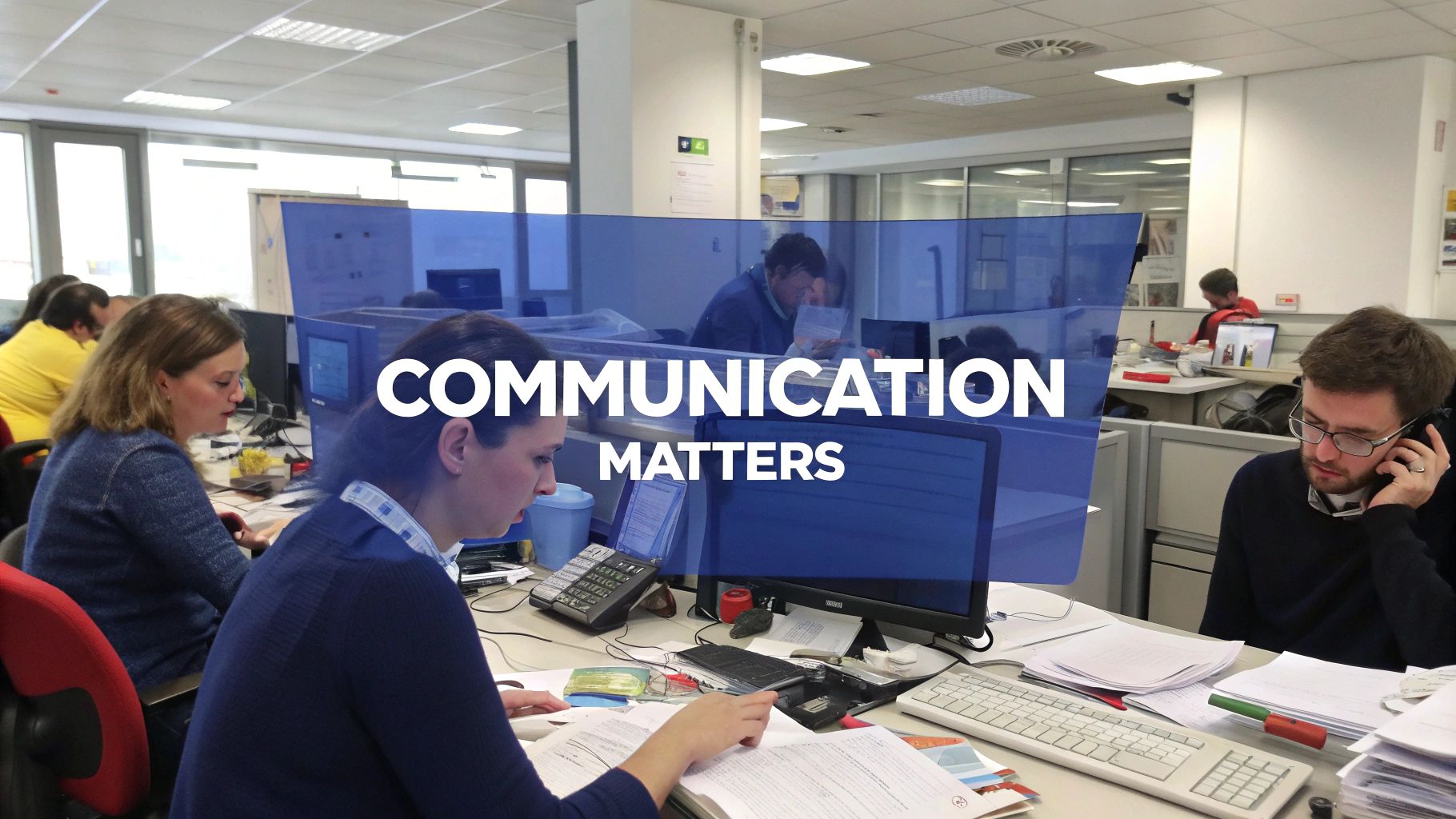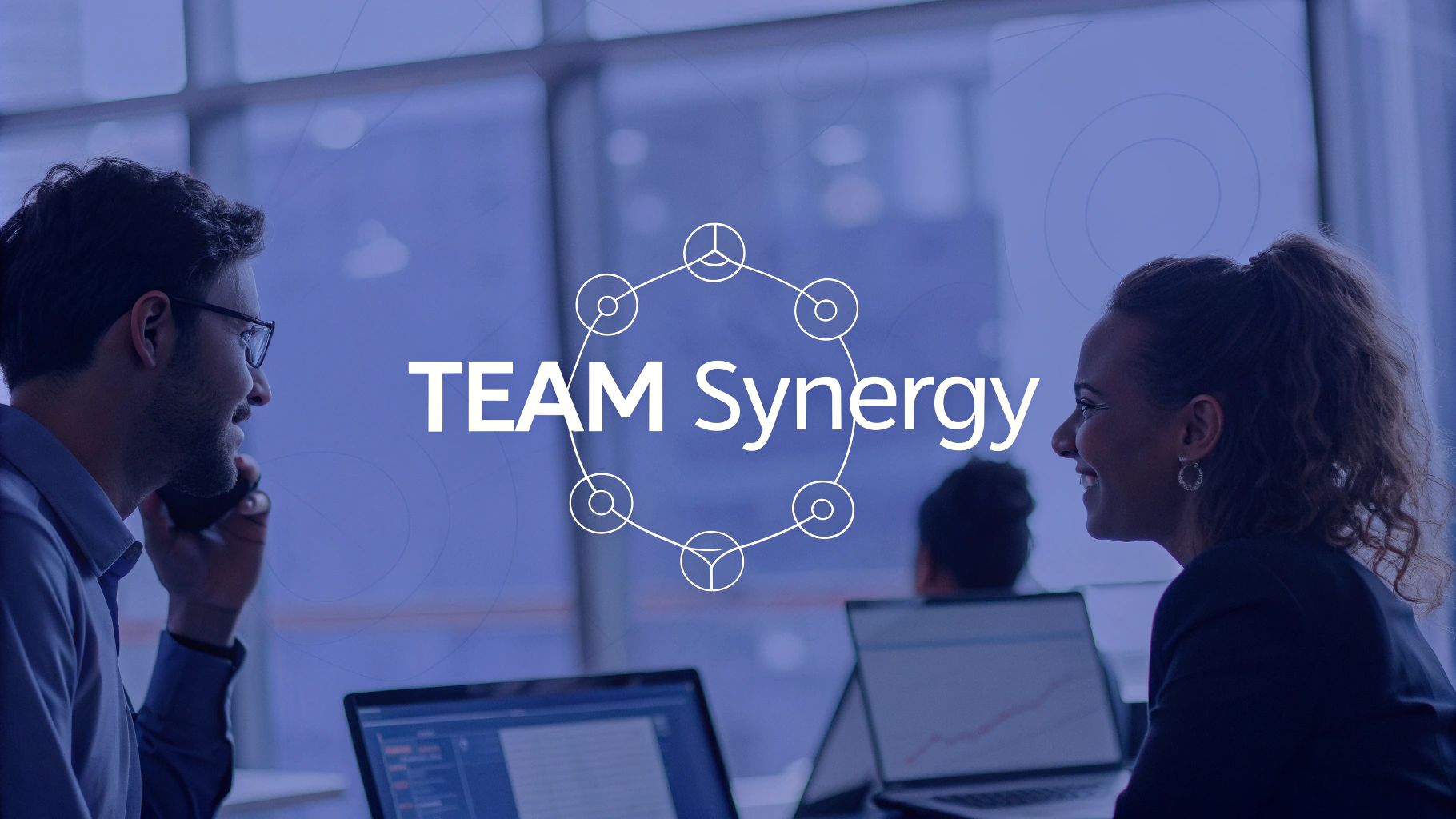The Impact of Poor Team Communication

Imagine a rowing team, each member pulling at a different pace and in a different direction. While they expend considerable energy, the boat barely moves forward. This scenario perfectly illustrates a team struggling with poor communication. Individual effort might be high, but the absence of a shared understanding and unified direction significantly hinders overall progress. Improving team communication isn't about simply increasing the volume of conversation; it's about building a collaborative environment where everyone is aligned and working towards a common goal. This shared understanding has a direct impact on your bottom line.
The Domino Effect of Miscommunication
Miscommunication isn't an isolated incident; it's a catalyst for a chain reaction that negatively impacts many aspects of a team's performance. This means that addressing communication breakdowns is critical for improving efficiency. For instance, when information isn't shared clearly or promptly, it can lead to duplicated work, missed deadlines, and ultimately, project failures. Furthermore, miscommunication breeds frustration and resentment among team members, eroding trust and damaging morale. As a result, productivity decreases, employees disengage, and turnover rates can rise. Consequently, projects suffer, team dynamics deteriorate, and the organization's full potential remains untapped.
Quantifying the Cost of Communication Breakdowns
The consequences of poor communication are not just theoretical; they are quantifiable. Research shows that companies with ineffective communication strategies can lose tens of millions of dollars annually. This substantial figure emphasizes the financial burden of misunderstandings and misaligned objectives. However, the costs extend beyond monetary loss. Consider the damage to your company's reputation when clients receive conflicting information or projects are consistently delayed due to internal communication problems. This can result in lost clients, diminished brand trust, and a weakened position in the market. Therefore, improving team communication is a strategic investment that yields significant returns in both productivity and profitability.
Transforming Losses into Gains
Shifting the focus towards improving team communication is a strategic move that can dramatically enhance team performance. Just as the rowers in our earlier example need to synchronize their movements for effective propulsion, teams need clear communication channels and strategies to achieve their objectives. This involves implementing tools and processes that streamline the flow of information, ensuring everyone can access the information they need, precisely when they need it. Moreover, cultivating a culture of open communication, active listening, and constructive feedback creates a more positive and collaborative work environment. By investing in these improvements, you empower your team to perform at its best, unlocking their full potential and driving significant business growth.
Essential Communication Tools and Platforms
Improving team communication through the right tools and platforms is like upgrading your team's operating system. A faster, more efficient system results in smoother operations, fewer errors, and ultimately, better output. This means that selecting the right communication tools and platforms is essential for success. Just as a skilled craftsperson needs the right tools for their craft, a team needs the right platforms to communicate effectively. This extends beyond simply having a chat application; it requires strategically choosing and integrating tools that support a variety of communication needs.
Selecting the Right Tools for the Job
Imagine building a house with only a hammer. While some progress might be made, the process would be slow, inefficient, and the final result would likely be unstable. Similarly, relying on a single communication tool for all team interactions limits your effectiveness. Improving team communication requires a diverse set of tools to address different communication styles and purposes. For instance, instant messaging is perfect for quick questions and informal updates, while project management software facilitates structured communication and task delegation. Video conferencing tools, on the other hand, bridge geographical gaps and enable face-to-face interaction, fostering stronger relationships and minimizing misinterpretations.

Integrating Tools into Workflow
Selecting the right tools is only the beginning. Integrating them effectively into your team's workflow is crucial for improving team communication. Think of these tools as ingredients in a recipe: having quality ingredients is essential, but the final dish depends on how well they are combined. This means establishing clear guidelines for how and when each tool should be used. For example, project updates might be shared through the project management platform, while quick questions are directed through instant messaging. This structured approach prevents information overload and ensures that messages reach the right people efficiently. Consistent use across the team promotes familiarity and reduces the learning curve for new members. Learn more in our article about collaborative feedback tools for efficient team reviews. By strategically integrating these tools, you create a seamless communication ecosystem that empowers your team to collaborate effectively and achieve common goals.
Establishing Communication Protocols
Integrating communication tools effectively, as discussed previously, is essential, but it's only the foundation for improving team communication. It's like having a high-performance car: the potential is there, but without clear driving instructions (communication protocols), you won't reach your destination efficiently. Establishing these protocols provides a roadmap for your team's communication, ensuring everyone understands the rules and can navigate conversations effectively. This section explores how to create, implement, and refine these vital guidelines.
Defining Clear Communication Channels
Just as a city needs a well-planned network of roads and signs to manage traffic, teams need clearly defined communication channels to manage the flow of information. Improving team communication hinges on designating specific channels for different types of communication. This prevents confusion and ensures messages reach the intended audience quickly. For example, urgent updates are best conveyed through instant messaging, while detailed project discussions are better suited to a dedicated project management platform. This structured approach reduces the risk of crucial information getting lost and allows team members to quickly find what they need.
Setting Expectations for Response Times
Imagine calling for emergency services and having to wait hours for a response – it’s unacceptable. Similarly, in a team setting, unclear expectations for response times create bottlenecks and frustration. Improving team communication means setting realistic and consistent response time expectations for various communication channels. This could involve establishing guidelines like responding to emails within 24 hours or addressing urgent messages within an hour. This clarifies responsibilities and helps team members manage their workload effectively. Additionally, defining clear escalation protocols for urgent matters ensures they receive prompt attention, preventing delays and potential problems. You might be interested in: How to centralize team feedback.
Implementing Regular Communication Rhythms
Regular communication rhythms, such as team meetings or daily check-ins, are vital for a healthy team. Like a conductor setting the tempo for an orchestra, these rhythms create a predictable structure for communication and keep everyone synchronized. Improving team communication depends on these structured interactions to ensure everyone is aligned on priorities and progress. These regular check-ins provide a forum for addressing challenges, celebrating accomplishments, and fostering a sense of shared purpose. This doesn’t necessarily mean endless meetings, but rather focused, efficient sessions designed for information sharing and collaboration. Moreover, these rhythms offer a platform for team members to voice concerns, offer suggestions, and contribute to the team's overall strategy. By establishing these consistent communication patterns, you create a foundation for effective collaboration and improved communication.
Documenting and Sharing Communication Protocols
Just as a comprehensive user manual helps people understand how to operate complex equipment, documenting and sharing communication protocols ensures everyone is on the same page. Improving team communication requires making these guidelines readily available to all team members, both new and existing. This promotes consistency and clarity across the team, regardless of experience. This documentation should be a living document, regularly reviewed and updated as the team evolves and new communication tools are adopted. This proactive approach to documentation encourages shared understanding and empowers team members to communicate effectively, contributing to a more productive and collaborative environment.
Active Listening Techniques

While documented and shared protocols are the foundation, mastering active listening is crucial for excelling in team communication. Active listening goes beyond simply hearing words; it involves deeply engaging with the message being conveyed. It is a vital element of improving team communication and fosters a culture of understanding and respect. This section explores practical techniques to hone your active listening skills and enhance communication within your team.
Paying Attention: More Than Just Hearing
Think of conversation like catching a ball. Passive listening is letting the ball bounce off you, while active listening is catching it securely, examining it, and throwing it back thoughtfully. This involves consciously focusing on the speaker, both verbally and nonverbally. Avoid interrupting or formulating your response before they have finished speaking. Concentrate on their words, their tone, and their body language to grasp the complete message. For example, if a team member expresses frustration, active listening means acknowledging their feelings and understanding the underlying cause of their concern. By paying close attention, you demonstrate respect and establish a safe space for open dialogue.
Showing Engagement: Demonstrating Your Interest
Just as musicians respond to the conductor's cues, active listening requires showing visible and audible signs of engagement. This reassures the speaker that their message is being heard and valued, leading to improved team communication. This might include nodding, maintaining eye contact, and offering verbal affirmations like "I understand" or "Tell me more." These cues signal your active involvement and encourage the speaker to continue sharing their thoughts and ideas. Additionally, reflecting back what you've heard, through paraphrasing or summarizing, confirms your understanding and provides an opportunity for clarification. By demonstrating genuine interest, you build rapport and strengthen communication.
Asking Clarifying Questions: Ensuring Understanding
Trying to assemble furniture with missing instructions is frustrating. Similarly, unclear communication leads to confusion and misunderstandings within a team. Improving team communication hinges on asking clarifying questions to ensure a shared understanding. This means posing thoughtful questions to gain deeper insights into the speaker's perspective. For instance, if a team member proposes a new strategy, asking questions about its practicality and potential impact helps refine the idea and address potential challenges. These questions aren't meant to challenge or interrogate, but rather to show interest and ensure everyone is on the same page. By seeking clarity, you prevent misinterpretations and foster collaborative decision-making.
Providing Constructive Feedback: A Catalyst for Growth
Active listening doesn't end with understanding; it also includes providing thoughtful, constructive feedback. Just as a coach helps an athlete refine their technique, constructive feedback helps team members improve their performance and, in turn, team communication. This feedback should be specific, actionable, and focused on behavior rather than personality. For example, instead of saying, "You're not a good communicator," suggest, "Try summarizing key points after a meeting to ensure everyone understands the next steps." By delivering constructive feedback supportively, you contribute to individual growth and strengthen the overall team dynamic. This promotes continuous improvement and empowers team members to communicate more effectively.
Virtual Team Communication

Establishing clear communication protocols and practicing active listening are paramount, and their importance is amplified for geographically dispersed teams. Improving team communication in a virtual setting demands a nuanced approach, acknowledging the specific challenges and opportunities of remote work. This means adapting strategies and tools to bridge the physical distance and maintain a strong sense of connection. This section explores key strategies for improving communication within virtual teams.
Overcoming the Challenges of Distance
Imagine conducting an orchestra with musicians spread across different cities. Achieving a harmonious performance would require exceptional coordination and communication. Similarly, virtual teams face the hurdle of maintaining effective communication despite physical separation. This can lead to feelings of isolation, misinterpretations, and difficulty building rapport. These challenges, however, can be addressed with strategies that promote connection and seamless information sharing.
Leveraging Technology for Seamless Communication
Just as a conductor uses a baton to guide the orchestra, technology serves as the primary tool for guiding communication in virtual teams. Improving communication in a remote setting heavily relies on choosing and utilizing the right platforms. This means using video conferencing tools for face-to-face interaction, instant messaging for quick updates, and project management software for organized collaboration. Tools like BugSmash, for example, allow for seamless feedback and review on various media, streamlining communication and fostering clarity. Cloud-based document sharing platforms ensure everyone can access the latest information, regardless of their location. By strategically leveraging technology, virtual teams can overcome the limitations of distance and maintain efficient workflows.
Building a Strong Virtual Team Culture
While technology facilitates communication, a strong virtual team culture is the binding force that holds the team together. Think of it as the shared understanding and mutual respect that allows an orchestra to play in sync. Improving communication in a virtual environment requires cultivating a sense of belonging and shared purpose. This can be achieved through regular virtual team-building activities, informal online social gatherings, and consistent recognition of individual contributions. Creating opportunities for team members to connect personally strengthens relationships and builds trust. Nurturing a positive and inclusive virtual team culture establishes a supportive environment where team members feel valued, connected, and motivated to collaborate.
Establishing Clear Communication Norms for Remote Teams
Just as a musical score provides the framework for a performance, establishing clear communication norms provides the framework for effective interaction within virtual teams. Improving communication in this context involves setting clear expectations regarding communication frequency, preferred channels, and response times. For instance, implementing daily check-in meetings or weekly progress reports ensures everyone stays informed and aligned. Defining clear guidelines for using email, instant messaging, or video conferencing prevents communication overload and ensures messages reach the right people efficiently. By implementing these structured communication norms, virtual teams can navigate the complexities of remote work and achieve shared goals more effectively.
Measuring Communication Success
Establishing clear communication norms and fostering active listening are essential steps toward improving team communication. However, to truly optimize these strategies, measuring their effectiveness is critical. Just as a gardener monitors plant growth to ensure they thrive, measuring communication success helps identify what’s working, what needs improvement, and how to continuously refine your approach. This proactive approach guarantees that your communication efforts generate tangible results and contribute to a more productive and collaborative work environment.
Key Metrics for Evaluating Communication Effectiveness
Trying to navigate a city without a map or GPS is inefficient and frustrating. Similarly, attempting to improve team communication without tracking key metrics can lead to wasted effort and missed opportunities. This means defining specific, measurable indicators that reflect the quality of your team's communication. For example, tracking the frequency and resolution time of communication-related issues can pinpoint areas where processes need to be streamlined. Measuring employee satisfaction with communication channels and practices provides valuable insights into team morale and engagement. By consistently monitoring these metrics, you gain a clear understanding of your team's communication strengths and weaknesses.
Gathering Feedback: The Voice of Your Team
Just as a chef relies on customer feedback to improve recipes, gathering feedback from your team is crucial for improving communication. This means creating avenues for team members to share their perspectives on communication effectiveness. This can be done through anonymous surveys, regular feedback sessions, or informal one-on-one discussions. Asking team members about the clarity of project briefs or the effectiveness of team meetings can reveal valuable insights into areas for improvement. This feedback is not just about problem identification; it's about recognizing and leveraging successful strategies to enhance communication further. By actively seeking and valuing team feedback, you cultivate open communication and continuous improvement.
Utilizing Communication Audits for Deeper Insights
While regular feedback is invaluable, periodic communication audits offer a more comprehensive assessment of your team’s communication health. Consider these audits as a thorough check-up for your team’s communication system, identifying potential bottlenecks and areas for optimization. These audits might involve analyzing communication flows, assessing the effectiveness of existing tools, and uncovering opportunities to streamline processes. For example, an audit might reveal that certain communication channels are underutilized or that information silos impede collaboration. These insights can inform strategic decisions about tool adoption, process improvement, and training initiatives. Conducting periodic communication audits provides a deeper understanding of your team’s communication dynamics and reveals opportunities to enhance effectiveness.
Actionable Insights: Turning Data into Improvement
Collecting data is only useful if it leads to action. Just as a doctor uses diagnostic results to create a treatment plan, using data from communication metrics and feedback to refine your strategies is essential for improvement. This means pinpointing specific areas for improvement and implementing concrete solutions. For example, if feedback indicates unproductive team meetings, introducing a structured agenda and clear objectives can drastically improve their effectiveness. If data reveals consistently unclear project briefs, implementing a standardized template and review process can enhance clarity and reduce confusion. By turning insights into action, you ensure your measurement efforts lead to tangible improvements in team communication and overall productivity.
Streamline your team's communication and feedback processes with BugSmash! Our platform makes it easy to annotate various media files, centralize feedback, and close communication loops quickly. Start your free trial today and experience the difference: https://bugsmash.io/




